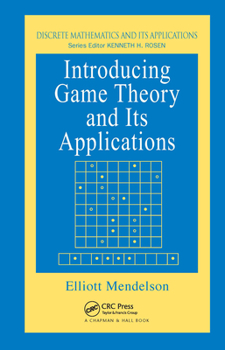Introducing Game Theory and Its Applications
The mathematical study of games is an intriguing endeavor with implications and applications that reach far beyond tic-tac-toe, chess, and poker to economics, business, and even biology and politics. Most texts on the subject, however, are written at the graduate level for those with strong mathematics, economics, or business backgrounds.
Format:Hardcover
Language:English
ISBN:1584883006
ISBN13:9781584883005
Release Date:June 2004
Publisher:CRC Press
Length:272 Pages
Weight:1.10 lbs.
Dimensions:0.7" x 6.4" x 9.6"
Customer Reviews
2 ratings
An springboard to more advanced texts.
Published by Thriftbooks.com User , 15 years ago
I came across this title back in 2004 on our school library's new book shelf. Being an introductory text, the range of topics and the level of mathematics it features is not geared towards a graduate course in the subject (which is what I was looking for at the time). However the exposition is perfectly suited for a junior or senior audience in the applied math, operations research, or economics majors. The coverage of the combinatorial games is a very welcome addition, and there is also a nice chapter on nonzero sum and n-person games which discusses among other things Shapley's Theorem and Imputations. The book bibliography provides numerous references for delving deeper into the specific topics of interest to the readers. After reading Mendelson, students can move on to more advaced texts such as Osborne/Rubinstein, or Fudenberg/Tirole. All in all, this title is recommended to anyone trying to read up on and understand game theory, starting from its basic methods and principles.
approachable Introduction
Published by Thriftbooks.com User , 19 years ago
Introducing Game Theory and its Applications by Elliot Mendelson (Chapman & Hall/CRC) The mathematical study of games is an intriguing endeavor with implications and applications that reach far beyond tic-tac-toe, chess, and poker to economics, business, and even biology. Most texts on the subject, however, are written at the graduate level for those with strong mathematics, economics, or business backgrounds. In a clear and refreshing departure from this trend, Introducing Game Theory and Its Applications presents an easy-to-read introduction to the basic ideas and techniques of game theory. After a brief introduction, the author begins with a chapter devoted to combinatorial games-a topic neglected or treated minimally in most other texts. The focus then shifts to two-person zero-sum games and their solution. Here the author presents the simplex method, based on linear programming, for solving these games and develops within his presentation the required background in linear programming. The final chapter presents some of the fundamental ideas and tools of non-zero-sum games and games with more than two players, including an introduction to cooperative game theory. Excerpt: This book will not only satisfy the curiosity of those whose interest in the subject was piqued by the 1994 Nobel Prize awarded to Harsanyi, Nash, and Selten. It also prepares its readers for more advanced study of game theory's applications in economics, business, and the physical, biological, and social sciences. This book is intended to be an easy-to-read introduction to the basic ideas and techniques of game theory. It can be used as a class textbook or for self-study. It also could be helpful for students who must learn some game theory in a course in a related subject (such as microeconomics) and have limited mathematical background. In recent years, and especially since the Nobel Prize in Economics was awarded in 1994 to John C. Harsanyi, John F. Nash Jr., and Reinhard Selten for their research in game theory, people have been intrigued by the unusual connection between games and mathematics, and the author hopes that this curiosity may be satisfied to some extent by reading this book. The book also will prepare them for deeper study of applications of game theory in economics and business and in the physical, biological, and social sciences. The first part of the text (Chapter 1) is devoted to combinatorial games. These games tend to be more recreational in nature and include board games like chess and checkers (and even a simple children's game like Tic-Tac-Toe). There are also many such games that are challenging even for accomplished mathematicians and our study covers various clever techniques for successful play. The rest of the book deals with the general theory of games. Chapters 2 and 3 contain a thorough treatment of two-person zero-sum games and their solution, which is the most well-understood part of game theory and was developed from the 1920s throug




